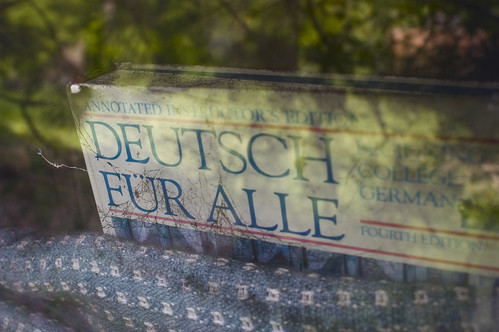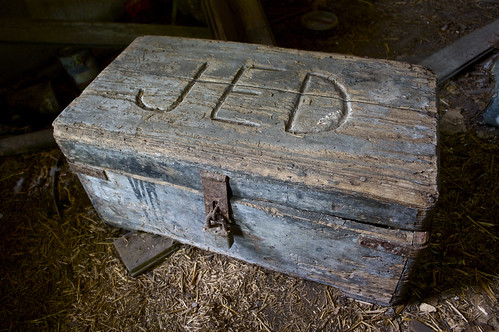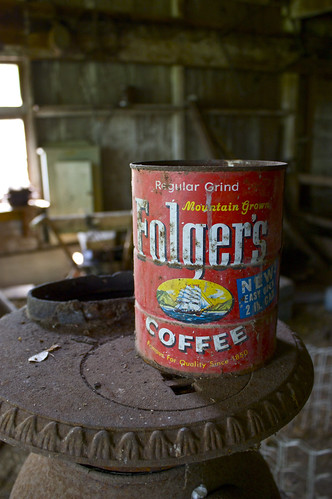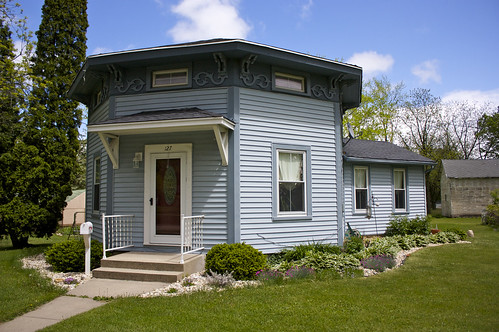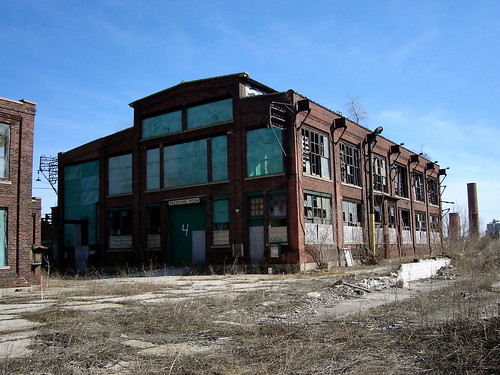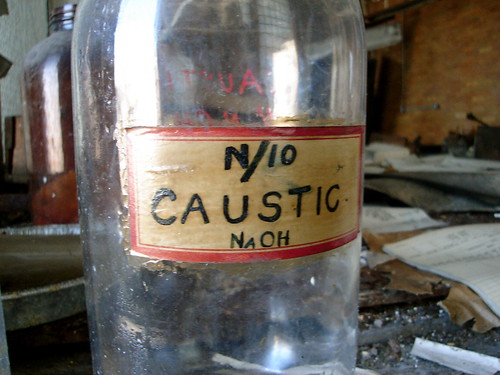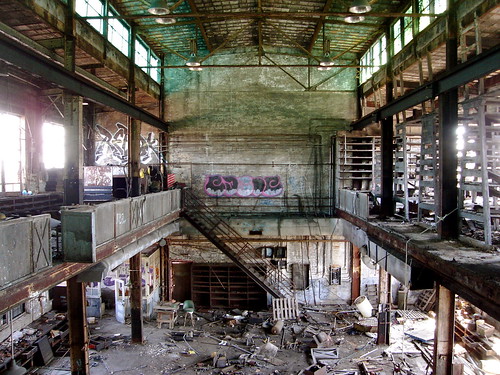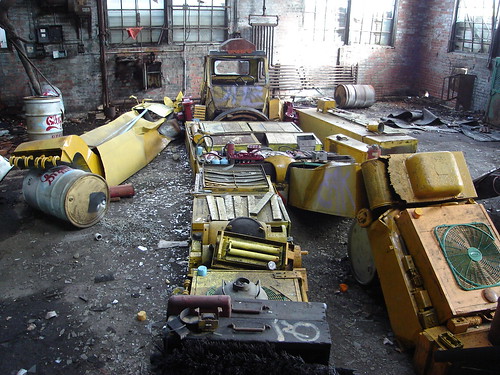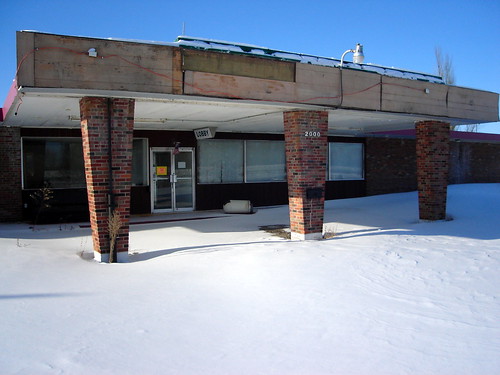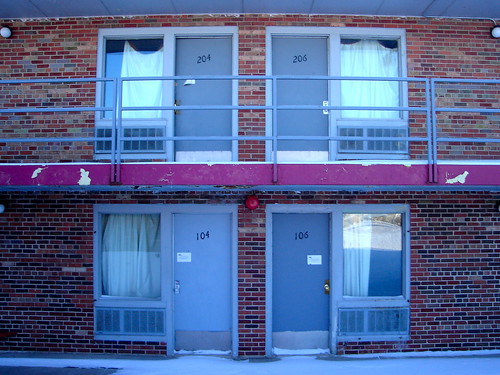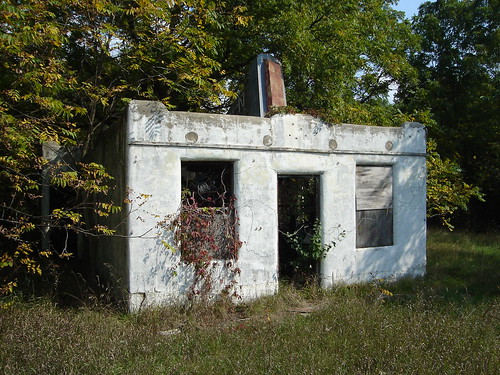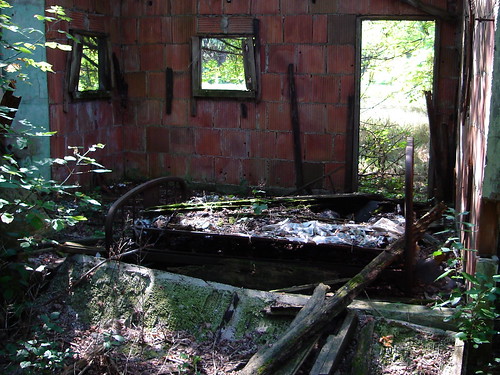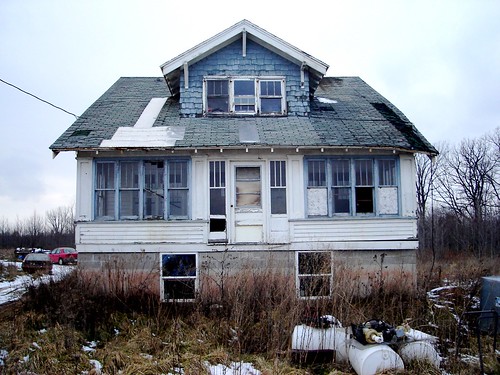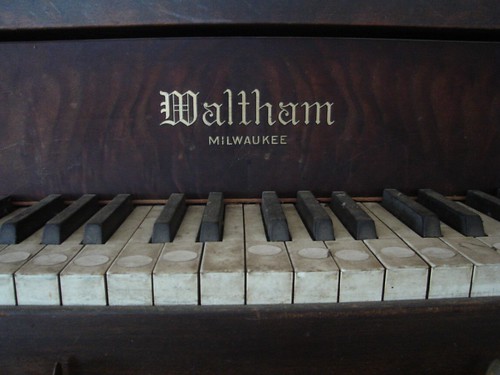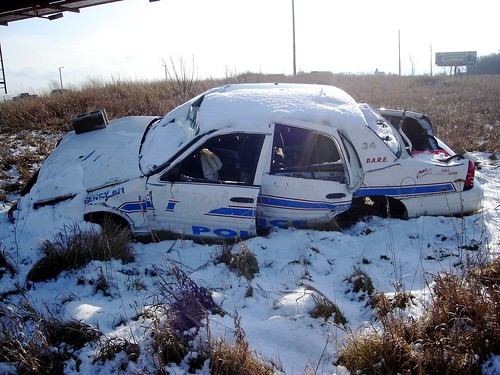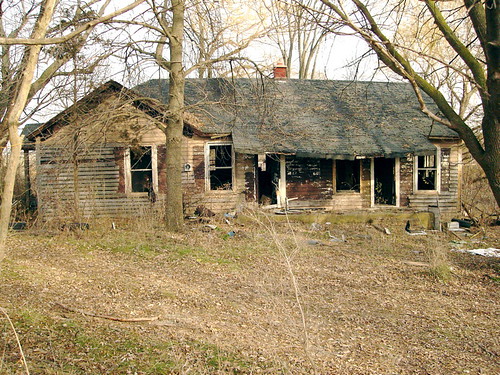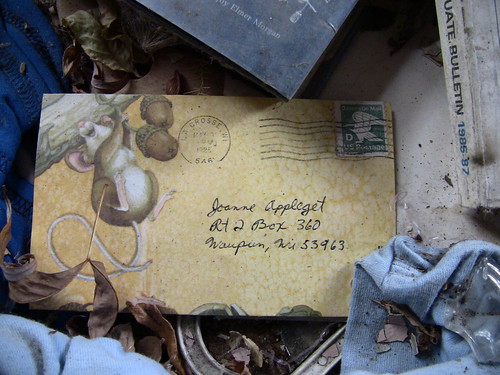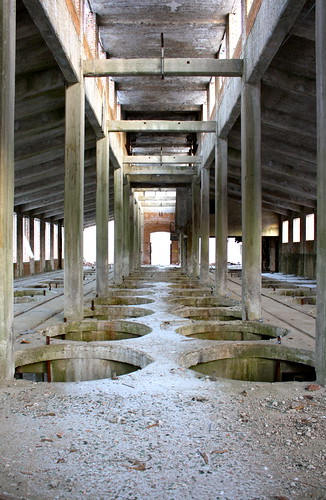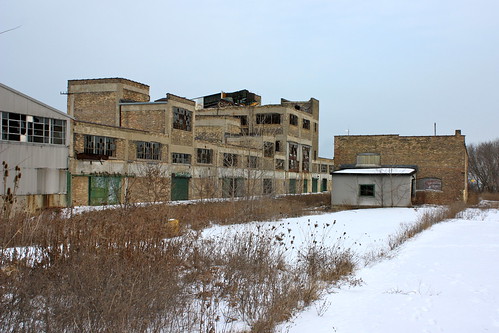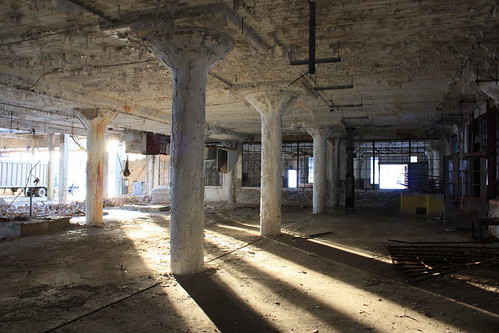These photos were taken on a property outside of Sullivan, WI. The property appears to be kept up, albeit infrequently. It is clear that no one lives on the property because old mail has piled up by the doors.
Tag Archives: wi
Octagon House in Whitewater, WI
Urbex doesn’t have to be about infiltrating abandoned buildings all the time. Sometimes you just have to walk around the neighborhoods that surround you and talk to people. I spoke with the sister of the home’s owner, who was packing her car. Erin did not know much of the history of the home, but she did tell me about the inside. The basement is a dirt foundation and not currently used for much. The ground level floor has a living room, kitchen, and small dining area. There is indeed a second floor to this home. A very tiny staircase leads to two bedrooms and a bathroom on the second floor. The home is currently occupied by a man, woman, and their young daughter.
One source claims that the house was built in 1855. I will have to return to the library and confirm this.
Solvay Coke & Gas
The Solvay Coke & Gas plant sits in a prime real-estate area of Milwaukee. The plant originally opened in 1906 and closed its doors in April, 1983. Plans to demolish the expansive site have been in the works for years, but the intensive cleanup efforts mandated by the EPA have put this plant in limbo. It is, after all, a Superfund site. Arsenic, lead, asbestos, and a whole host of other chemicals have been mixed into the ground.
Don’s Rail Photos website describes what went on at this once state of the art facility.
Coal was brought in by boat and by rail and lifted to the top of the tipple. It was then dropped into an extremely wide gauge electric rail car which ran on the top level and took power by trolley from the wire at the front edge. The coal was then dropped into ovens where it was heated to a high temperature in a low oxygen atmosphere. The carbon reacted with the oxygen to produce carbon monoxide, or coal gas. There were also other smaller amounts of gasses trapped in the coal. The gases were collected and sent to storage tanks. The resulting hot carbon was then pushed out the front door of the oven into a hopper car and sent to a quenching tower. This produced coke.
The first time I visited the Solvay Coke & Gas site I was shocked by its location. We were not more than one city block from a major Milwaukee shopping center, but yet it felt like we had entered another world entirely. The site is absolutely massive in scale. What remains though is only a fraction of what used to be. Concrete foundations of buildings long gone still remain. (Take a closer look at the map above.)
In its present state the Solvay site has four main buildings and a trailer. The first time I entered the front offices my urbex partner and I heard water flowing in the basement. Upon investigating we saw four inches of standing water and could hear a steady flow. When I visited a second time there was a clear watermark that was up to the ceiling of the basement. The second floor has a room with an ornate fireplace and a well stocked bookshelf. Unfortunately vandals have since destroyed these treasures and smashed all but a few of the glass windows.
The next building behind the offices houses a labratory on the second floor. Some of the scientists’ instruments remain behind. Bottles full of unknown substances, extensive logs, and even samples can still be found here. It is unfortunate, though, that the last time I visited this building water had filled the basement completely. It has made the wood floor very unstable.
The largest building on the site is all that remains of the main factory floor. On the last trip I stumbled across a giant passed out drunken robot. I do not condone the desecration of urbex locations, though this robot made me reconsider my stance. It is a beautiful work of art that only those brave enough to venture out to such a location can enjoy. Bravo, whoever created this.
Research Links:
Very descriptive health consultation about the Solvay site
Solvay Community Involvement Plan (PDF)
JS Online article discussing redevelopment of the site
Old operational photos of Solvay Coke & Gas
Alexander Fortney’s thesis revolving around the Solvay site
Asbestos abatement project from 2004
Milwaukee BizJournal article on new owners from 2006
The Fox Inn
Welcome to the Fox Inn. Rooms are available for as low as $22 a night. Well… they were at some point. The Winnebago County Health Department has something else to say about that.
Being right next to H41 this place attracts a lot of attention. The first floor and stairwells are now boarded up completely. Patrols drive past this location quite frequently. The last time I was here shooting footage for a documentary the local Sheriff asked what I was up to. I explained that I was merely shooting footage and would be immediately on my way out. This is a good tip for any urbexer. Don’t run from the police. Just be cool, explain yourself, be friendly and listen to what they tell you to do. Being confrontational and acting suspicious is a great way to end up with a ticket.
So what is the story behind the Fox Inn?
One uncredited source says it closed in January, 2008. At the time I lived in Oshkosh and this seems to comport with what I saw when driving to Appleton. The Fox Inn used to be called the Northern Inn. The last major news item was a triple shooting committed by Chuckie Vang in 2005. Vang has since been captured thanks to a 2008 America’s Most Wanted broadcast detailing his crime. The Menasha Police Department highlighted the arrest in a public report (PDF). Before closing the Fox Inn was home to low-income families and people down on their luck. The Post Crescent ran an article on one such family living in the motel.
Haven Motel
Welcome to the Haven Motel.
Well, that’s what it was renamed to in 1958 and remained so until the 1980’s. When Ozzie & Harriet Nelson, boxer Joe Louis, and the von Trapp family of The Sound of Music fame stayed here it was known as Lein’s Cabins.
The adobe structures now sit in a state of disrepair. Whenever I drive past them on H12 I’ve noticed that they are decaying quite rapidly now that the weather has loosened the internal brickwork.
Research Links:
H41 Junkyard
Heading along H41 in Kaukauna, Wisconsin you’ll pass this dilapidated house. It appears to have been vacated sometime in the 1990’s. Entering through the basement doors reveals a peculiar oddity. The foundation and windows appear to be fairly new, while the main home is clearly quite older. Most of the basement is filled with possessions of the former owner(s). A newer sturdy stairwell leads to what can be assumed to be the former first floor. Heavier items were moved into the living and dining room areas, but not much beyond that. There was a beautiful Waltham piano in the living room, though vandals have since destroyed it completely. The upstairs is almost completely devoid of human traces.
What most likely happened is the house was moved from its original location. In the process the owner must have fallen on hard times or passed away. The property passed on to the next of kin and the property fell into disrepair.
If you don’t get off highway to look at this home, you never see the trail that leads to a forest behind the home. Following it takes you past several abandoned vehicles. For some reason the Oshkosh Police Department saw fit to abandon a vehicle there too. Entering the wooded area leads more trailers to explore.
Protip: Wear heavy boots. This place has a lot of rusty metal littered everywhere.
Abandoned Waupun Farm
The exact location of this urbex site will not be shared in the interest of preservation. In April, 2010 while passing by I noticed that a significant amount of brush that had concealed the home has been cleared away. Signs warning trespassers have now been posted on the property.
This farm belonged to the Appleget family before being abandoned sometime in the late 1980/early 90’s. This house has an unusual amount artifacts left behind by the family. It is unclear why they left so much behind. Any information would be greatly appreciated.
What is known is that someone in the family taught at Green Bay West High School in 1965. At least one member of the family was diabetic as evidenced by the NPH insulin and syringes located among the rubble. Someone graduated from the University of Wisconsin – Madison. Joanne Appleget kept her mail correspondence and some of it remains unopened.
Peter Cooper Glue Factory
Please see the Peter Cooper Glue Factory research post.
Hynite Company
The Hynite Company property is adjacent to the Peter Cooper building. This structure often gets confused for the Peter Cooper building. This location is mentioned in the US Department of Health & Human Services report.
The Hynite Company reportedly opened in Carrollville during the 1920s to manufacture nitrogenous fertilizers leather meal from waste leather. It is not clear to DHFS when such manufacturing halted at the Hynite property.
Tucked behind the southeast corner of the former Peter Cooper property is the 8-acre former Hynite property. Viewed from the end of East Depot Road, staff saw two buildings, a smaller, brick office with a vehicle scale on the south side, and larger multi-storied brick building estimated to be about 22,500 sq ft, with a newer 13,500 sq ft structure attached to the east side. Aerial photos of the Hynite property also show that on the northeast side of these buildings are several concrete foundation footprints of one or more prior buildings.
As of January 2010 the Peter Cooper building was under active demolition. It is a good bet that the Hynite building will meet a similar fate in the near future.
Please see the Peter Cooper Glue Factory research post.
Peter Cooper Glue Factory
Have you ever eaten Jell-O? If the answer is yes, then Peter Cooper has been a part of your life.
New York-based industrialist Peter Cooper received a patent for gelatin in 1845. He is also known for his other major contributions to American history. He also designed the first steam locomotive in the United States. To this date, he holds the record for being the oldest person ever nominated to run for President at the age of 85.
Located just south of Milwaukee in an area called Carrollville sits a huge abandoned complex of buildings at the end of a long road. For decades the Peter Cooper Glue Factory and adjacent business properties have remained dormant. It is a well-travelled urbex location.
The US Department of Health & Human Services wrote about the site in a report.
This area of Oak Creek is historically referred to as Carrollville, though many current Oak Creek residents may not be familiar with the name (Cech 2005). In 1899, the Milwaukee tanning industry established the U.S. Glue Company factory in Carrollville to make glue from remnants and scraps of animal hides, both tanned and untanned. During the 1930s, the U.S. Glue Company sold the factory to the Peter Cooper Corporation, who then sold the factory in 1976 to the French pharmaceutical company Rousselot. Manufacturing of glue continued at the factory until it closed in 1985.
For Milwaukee area old-timers the name Peter Cooper is synonymous with putrid stench. Julio Guerrero (PDF) includes an excerpt from the book Carrollville in Retrospect to explain why the area around the factory smelled so foul.
“The (cow) hides are washed, soaked in lime for 70 days to expand them, washed and treated with acid to neutralize the lime, then cooked in water until becoming a liquor which is spread out to dry for two and one-half hours in one of two million dollar ovens. The dry glue is then ground to a powder and sold. The drying ovens replaced the natural drying process that was handled by the flopper girls, who handled the 4’ x 6’ sheet of glue that seldom dried in a uniform way and often developed mold thereby causing the loss of the entire batch.”
The previously mentioned USDH&HS report details the fire that destroyed much of the Peter Cooper factory in 1987.
In November 1987, a fire broke out in the main buildings of the vacant Peter Cooper facility. This was one the largest fires in the history of Oak Creek, and the wooden structure was consumed by the blaze and fire fighters focused on saving adjacent buildings (Oak Creek FD, 2007). Cech (2005) states, “three of the four stories of the main building had been destroyed, the entire west wall had collapsed, and the remaining ground floor was gutted.”
As of January, 2010 the site was under active demolition.
Research Links:
Biographical information on Peter Cooper
Extensive writeup on Peter Cooper
Mention of the factory in The Milwaukee Journal
UER thread on Peter Cooper Glue
Urban Land Institute report with extensive statistical, geographic, and photographic information (PDF)
US Department of Health and Human Services report on health risks (PDF)
JS Online – Plans to demolish PCG move forward
Wikipedia article on Peter Cooper
